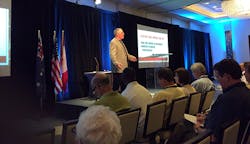PHOENIX — Contractors and service techs fail to sell add-ons for three reasons, sales trainer Joe Cunningham told members of the Service Roundtable meeting here: deficient knowledge, reluctance to execute, and fear of success. Cunningham, a million dollar contractor salesman before founding Success Tracknetwork in 1998, knows a bit about selling in customers’ homes.
Cunningham, speaking at the Service Roundtable’s International Roundtable here in mid-April, told the contractors seven steps they needed to take to get their businesses ready to sell and followed with the seven simple add-on sales secrets.
Number one, said Cunningham, is to educate your company and yourself. Make your company conducive to training; train regularly. Encourage your people to read. Read How To Master The Art of Selling by Tom Hopkins. It will tell you how to communicate with people, Cunningham noted. Read The Ultimate Sales Letter by Dan S. Kennedy. It will show you how to write the text of any sales or marketing piece that you want to put out. Finally, read This Old House Heating, Ventilation and Air Conditioning, written by industry icon Rich Trethewey back in 1994.
Second, systematize. Make it easy for your people, even inexperienced ones, to succeed. Develop what you think would be your perfect service call and write it all down. Design your paperwork to help your people sell more.
Third, make the most of every opportunity. Train your people to observe, find problems and then offer solutions. Create tools and prepare your employees to present solutions.
Fourth, monitor. Track what’s going on and post it on the bulletin board for everyone to see. Compare results to the goals you have set.
Fifth, manage effectively. Use your goals and your employees’ achievements to see where you need more training. Hold people accountable. If you can’t change your people, then you’ll have to change your people.
Sixth, maintain daily. When you miss your daily goals, figure out why and fix it. Remember, you don’t hit or miss your sales goals on a quarterly basis — it’s something you have to track every day.
Seventh, look forward and sell ahead. Prepare for tomorrow today. Have a mechanism for your sales people (like tips coming from the service techs) to generate sales leads for the future. Market every day.
Once you have your company properly set up to be successful selling, you can implement Cunningham’s seven simple add-on sales secrets.
What’s the biggest deterrent to in-home sales, Cunningham asked the contractors? There are no visible demonstrations. Homeowners, who know little about the industry’s products and technology, have to take a leap of faith. If the customer can’t tell one product from another, then they all become commodities. So take the customer for a test ride. Eighty to 90% of service calls are single-task calls, he noted, but the average house is 30-years-old. Each service call should present a lot of opportunities.
First, perform airflow and water testing. Testing gives you demonstration powers that no other company is offering. He required his technicians to test airflow in every single room, and sold a lot of duct repairs at an average of $8,000 a pop. Sell “high velocity” grilles and registers. Plumbers should always draw a water sample. Test the water pressure. High water pressure might void some product warranties. Check hot water temperatures for scalding danger. See a lot of bottled water and filter pitchers in the house? Suggest whole house water filtration.
Second, thermal imaging. Get the plug-in attachment that snaps into your smart phone from either Seek Thermal or FLIR. They’re great for showing leaks from either HVAC systems or the water leak under the slab, not to mention radiant floor heating work.
Third, ask for reviews. Services such as Leads Nearby or Review Buzz make it easy for both the homeowner and the contractor to generate reviews. Ask for reviews 100% of the time. You’ll rank higher on Google.
Fourth, subscribe to Cole Neighborhoods and do radius marketing. Cunningham suggested searching by aerial views. When you work at a house, send personalized, handwritten letters to the neighbors saying that you’d like to work for them.
Fifth, technician-based lead generation from customer service reports. Use paper invoices and checklists even if you’re a paperless office because customers see paper as something “real.” The checklists ensure that techs don’t miss anything. Promote service agreements on every call, including on your invoices, showing the regular price and the service agreement customer price.
Sixth, institute performance-based pay programs. If the technician knows that he can make more money, he’ll improve his observational and communications skills and educate himself. It’s not unusual, Cunningham said, to generate leads for future sales on 15% of service calls.
Seventh, follow-up with ongoing training through a best practice group like the Service Roundtable or a coach like Charlie Greer. Promote online training programs. Send your technicians to distributor programs. Quoting the author, salesman and motivational speaker Zig Ziglar, Cunningham pointed out that training is like bathing — once isn’t enough.
